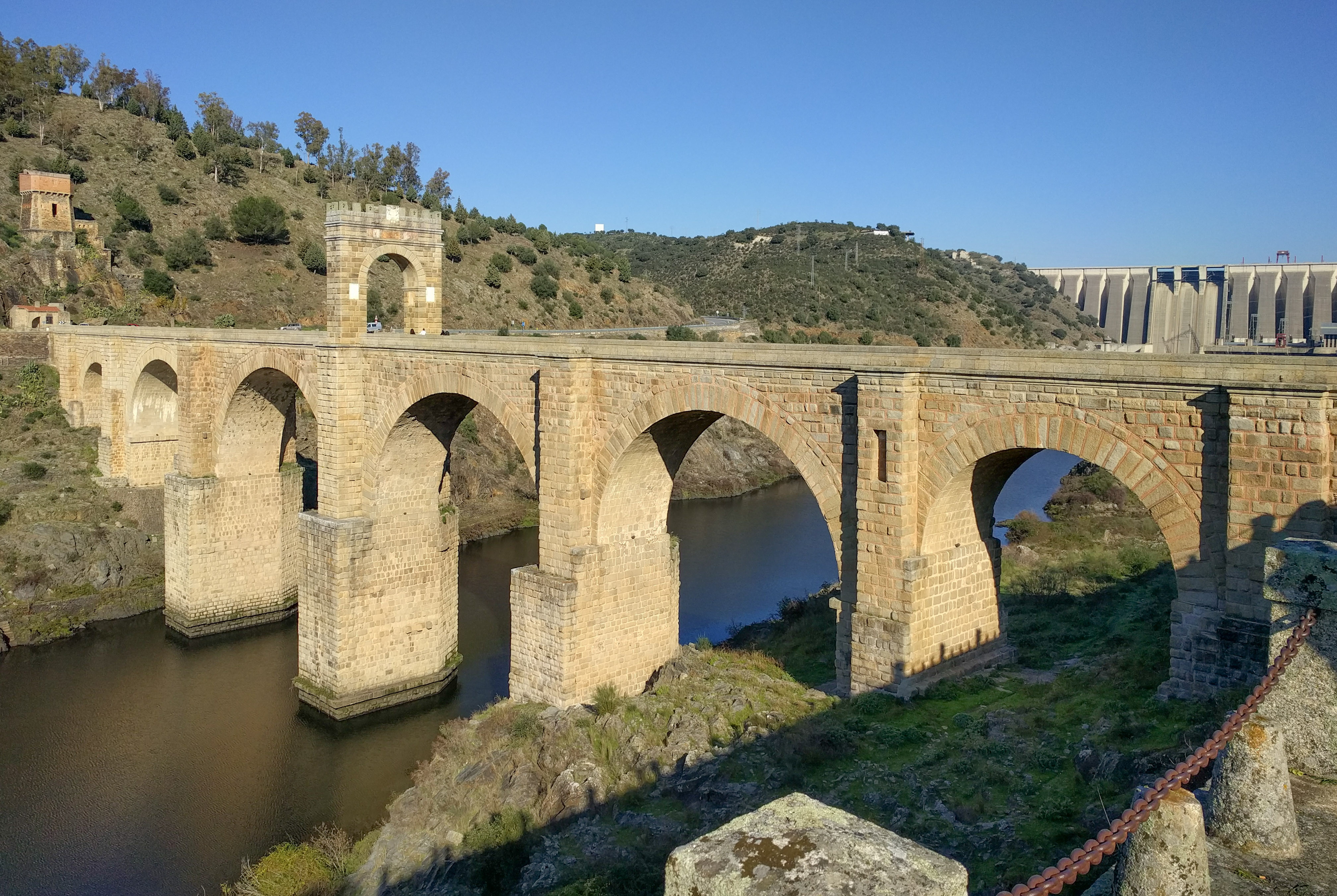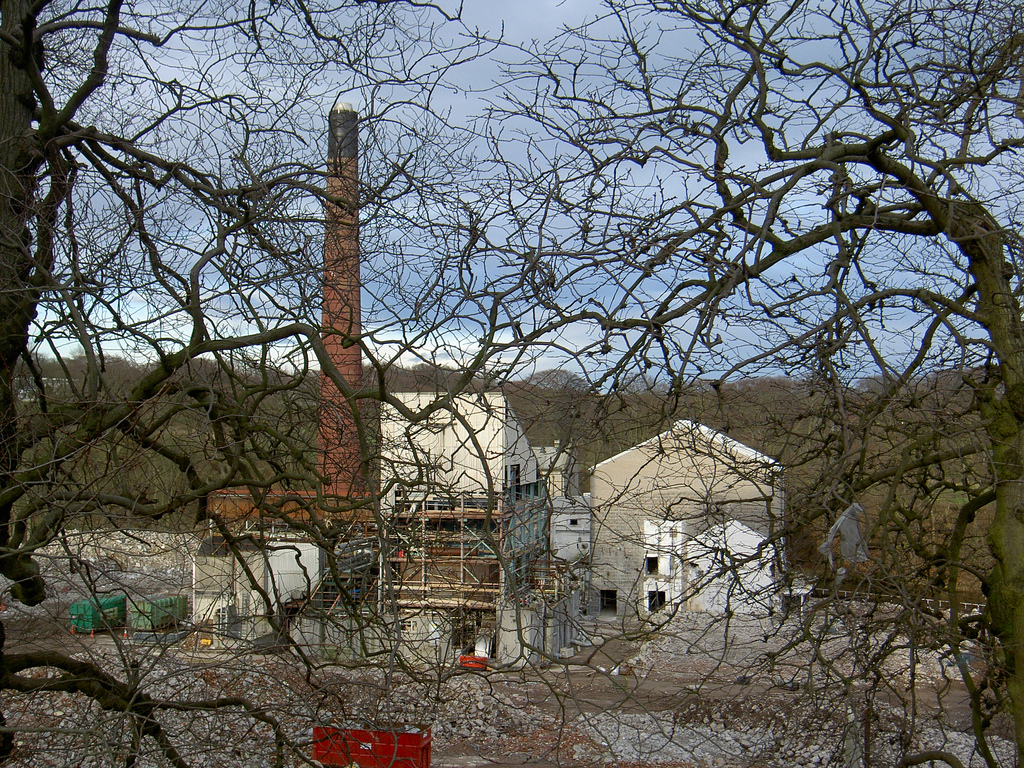|
Victoria Viaduct
Victoria Viaduct, originally known as the Victoria Bridge, is a stone arch rail viaduct spanning the River Wear about south-east of Washington in North East England. It was built as part of the Durham Junction Railway under the supervision of Thomas Elliot Harrison. History and design The bridge was constructed as part of the Durham Junction Railway, which had been sanctioned by act of parliament in 1834; the act allowed for traffic tolls on a bridge over the Wear, including tolls for road and foot crossing. A iron bridge suitable for passage by rail, foot and road vehicle was designed by John Green of Newcastle, but instead a stone arch bridge designed by James Walker was chosen. The contract to build the bridge was given to John Gibb & Son. of Aberdeen. The design was based upon the Alcántara Bridge in Spain. Construction began 17 March 1836 and was completed on 28 June 1838, the date of the coronation of Queen Victoria; as a result it was called 'Victoria Bridge'. ... [...More Info...] [...Related Items...] OR: [Wikipedia] [Google] [Baidu] |
Alcántara Bridge
The Alcántara Bridge (also known as Trajan's Bridge at Alcantara) is a Roman bridge at Alcántara, in Extremadura, Spain. Alcántara is from the Arabic word ''al-Qantarah'' (القنطرة) meaning "the arch". The stone arch bridge was built over the Tagus River between 104 and 106 AD by an order of the Roman emperor Trajan in 98. History The Alcántara Bridge has suffered more damage from war than from the elements over the years. The Moors destroyed one of the smallest arches in 1214 although this was rebuilt centuries later, in 1543, with stone taken from the original quarries. The second arch on the northwest side was then later destroyed in 1760 by the Spanish to stop the Portuguese advancing and was repaired in 1762 by Charles III, only to be blown up again in 1809 by Wellington's forces attempting to stop the French. Temporary repairs were made in 1819, but much of the bridge was destroyed yet again in 1836 by the Carlists. The bridge was rebuilt in 1860 ... [...More Info...] [...Related Items...] OR: [Wikipedia] [Google] [Baidu] |
Bridges Across The River Wear
A bridge is a structure built to span a physical obstacle (such as a body of water, valley, road, or rail) without blocking the way underneath. It is constructed for the purpose of providing passage over the obstacle, which is usually something that is otherwise difficult or impossible to cross. There are many different designs of bridges, each serving a particular purpose and applicable to different situations. Designs of bridges vary depending on factors such as the function of the bridge, the nature of the terrain where the bridge is constructed and anchored, and the material used to make it, and the funds available to build it. The earliest bridges were likely made with fallen trees and stepping stones. The Neolithic people built boardwalk bridges across marshland. The Arkadiko Bridge (dating from the 13th century BC, in the Peloponnese) is one of the oldest arch bridges still in existence and use. Etymology The ''Oxford English Dictionary'' traces the origin of the w ... [...More Info...] [...Related Items...] OR: [Wikipedia] [Google] [Baidu] |
Mothball
Mothballs are small balls of chemical pesticide and deodorant, sometimes used when storing clothing and other materials susceptible to damage from mold or moth larvae (especially clothes moths like '' Tineola bisselliella''). Composition Older mothballs consisted primarily of naphthalene, but due to naphthalene's flammability, many modern mothball formulations instead use 1,4-dichlorobenzene. The latter formulation may be somewhat less flammable, although both chemicals have the same NFPA 704 rating for flammability. The latter chemical is also variously labeled as para-dichlorobenzene, p-dichlorobenzene, pDCB, or PDB, making it harder to identify unless all these acronyms are known to a potential purchaser. Both of these formulations have the strong, pungent, sickly-sweet odor often associated with mothballs. Both naphthalene and 1,4-dichlorobenzene undergo sublimation, meaning that they transition from a solid state directly into a gas; this gas is toxic to moths and mot ... [...More Info...] [...Related Items...] OR: [Wikipedia] [Google] [Baidu] |
Beeching Axe
The Beeching cuts (also Beeching Axe) was a plan to increase the efficiency of the nationalised railway system in Great Britain. The plan was outlined in two reports: ''The Reshaping of British Railways'' (1963) and ''The Development of the Major Railway Trunk Routes'' (1965), written by Richard Beeching and published by the British Railways Board. The first report identified 2,363 stations and of railway line for closure, amounting to 55% of stations, 30% of route miles, and 67,700 British Rail positions, with an objective of stemming the large losses being incurred during a period of increasing competition from road transport and reducing the rail subsidies necessary to keep the network running. The second report identified a small number of major routes for significant investment. The 1963 report also recommended some less well-publicised changes, including a switch to the now-standard practice of containerisation for rail freight, and the replacement of some services ... [...More Info...] [...Related Items...] OR: [Wikipedia] [Google] [Baidu] |
Grosvenor Bridge (Chester)
The Grosvenor Bridge is a single-span stone arch bridge, arch road bridge crossing the River Dee (United Kingdom), River Dee at Chester, England. Located on the A483 road, A483 Grosvenor Road (), it was designed by Thomas Harrison (architect), Thomas Harrison and opened by Princess Victoria of Saxe-Coburg-Saalfeld on 17 October 1832. The first traffic passed over it in November 1833. At the time of its construction, the bridge was the longest single-span stone arch bridge in the world, a title that it retained for 30 years. It is recorded in the National Heritage List for England as a designated Grade I Listed building#England and Wales, listed building. Views upriver include Chester Castle and Handbridge, the impressive mansions of Curzon Park and the adjacent Roodee. Water levels of the tide, tidal Dee vary significantly during the day. History Design At the beginning of the 19th century, Chester only had one river crossing, a narrow Middle Ages, medieval brid ... [...More Info...] [...Related Items...] OR: [Wikipedia] [Google] [Baidu] |
Scotch Fir
''Pinus sylvestris'', the Scots pine (UK), Scotch pine (US) or Baltic pine, is a species of tree in the pine family Pinaceae that is native to Eurasia. It can readily be identified by its combination of fairly short, blue-green leaves and orange-red bark. Description ''Pinus sylvestris'' is an evergreen coniferous tree growing up to in height and in trunk diameter when mature, exceptionally over tall and in trunk diameter on very productive sites. The tallest on record is a tree over 210 years old tree growing in Estonia which stands at . The lifespan is normally 150–300 years, with the oldest recorded specimens in Lapland, Northern Finland over 760 years. The bark is thick, flaky and orange-red when young to scaly and gray-brown in maturity, sometimes retaining the former on the upper portion.Trees for LifeSpecies profile: Scots pine/ref> The habit of the mature tree is distinctive due to its long, bare and straight trunk topped by a rounded or flat-topped mass of f ... [...More Info...] [...Related Items...] OR: [Wikipedia] [Google] [Baidu] |
River Bed
A stream bed or streambed is the bottom of a stream or river (bathymetry) or the physical confine of the normal water flow ( channel). The lateral confines or channel margins are known as the stream banks or river banks, during all but flood stage. Under certain conditions a river can branch from one stream bed to multiple stream beds. A flood occurs when a stream overflows its banks and flows onto its flood plain. As a general rule, the bed is the part of the channel up to the normal water line, and the banks are that part above the normal water line. However, because water flow varies, this differentiation is subject to local interpretation. Usually, the bed is kept clear of terrestrial vegetation, whereas the banks are subjected to water flow only during unusual or perhaps infrequent high water stages and therefore might support vegetation some or much of the time. The nature of any stream bed is always a function of the flow dynamics and the local geologic materials, ... [...More Info...] [...Related Items...] OR: [Wikipedia] [Google] [Baidu] |
Semicircular
In mathematics (and more specifically geometry), a semicircle is a one-dimensional Locus (mathematics), locus of points that forms half of a circle. The full Arc (geometry), arc of a semicircle always measures 180° (equivalently, radians, or a turn (geometry)#Subdivision of turns, half-turn). It has only one line of symmetry (reflection symmetry). In non-technical usage, the term "semicircle" is sometimes used to refer to a half-Disc (geometry), disk, which is a two-dimensional geometric shape that also includes the diameter segment from one end of the arc to the other as well as all the interior points. By Thales' theorem, any triangle Inscribed figure, inscribed in a semicircle with a vertex (geometry), vertex at each of the endpoints of the semicircle and the third vertex elsewhere on the semicircle is a right triangle, with a right angle at the third vertex. All lines intersecting the semicircle perpendicularly are concurrent lines, concurrent at the center of the circle c ... [...More Info...] [...Related Items...] OR: [Wikipedia] [Google] [Baidu] |
Charles Barry
Sir Charles Barry (23 May 1795 – 12 May 1860) was a British architect, best known for his role in the rebuilding of the Palace of Westminster (also known as the Houses of Parliament) in London during the mid-19th century, but also responsible for numerous other buildings and gardens. He is known for his major contribution to the use of Italianate architecture in Britain, especially the use of the Palazzo as basis for the design of country houses, city mansions and public buildings. He also developed the Italian Renaissance garden style for the many gardens he designed around country houses.Bisgrove, p. 179 Background and training Born on 23 May 1795Barry p. 4 in Bridge Street, Westminster (opposite the future site of the Clock Tower of the Palace of Westminster), he was the fourth son of Walter Edward Barry (died 1805), a stationer, and Frances Barry ''née'' Maybank (died 1798). He was baptised at St Margaret's, Westminster, into the Church of England, of which he wa ... [...More Info...] [...Related Items...] OR: [Wikipedia] [Google] [Baidu] |
Aberdeen Granite
Aberdeen is one of the most prosperous cities in Scotland owing to the variety and importance of its chief industries. Traditionally Aberdeen was home to fishing, textile mills, ship building and paper making. These industries have mostly gone and have been replaced with high technology developments in the electronics design and development industry, research in agriculture and fishing, and the oil industry which has been largely responsible for Aberdeen's economic boom in the last three decades. Traditional (pre 1970) Most of the leading pre-1970s industries date from the 18th Century, amongst them woollens (1703), linen (1749), and cotton (1779). These gave employment to several thousands of operatives. The paper-making industry is one of the most famous and oldest in the city, paper having been first made in Aberdeen in 1694. The industry has however, collapsed. Culter Paper Mill closed in 1981, Donside Paper Mill closed in 2001 and the Davidson Mill (run by BPB Paperboard) i ... [...More Info...] [...Related Items...] OR: [Wikipedia] [Google] [Baidu] |






